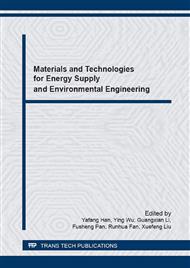[1]
F.Z. Wang, L. X, Tang, P.F. Feng, et al., Tungsten material and its processing, Beijing Metallurgical Industry Press, 2008, pp.2-530.
Google Scholar
[2]
M. Faleschini, H. Kreuzer, D. Kiner, et al. Fracture toughness investigations of tungsten alloys and SPD tungsten alloys, Journal of Nuclear Materials. 367-370(2007)800-805.
DOI: 10.1016/j.jnucmat.2007.03.079
Google Scholar
[3]
M.V. Aguirre, A. Martin, J.Y. Pastor, et al. Mechanical behavior of W-Y2O3 and W-Ti alloys from 25℃to 1000℃. Metallurgical and Materials Transactions A. 40(2009)2283-2285.
DOI: 10.1007/s11661-009-9956-4
Google Scholar
[4]
T.Q. Zhang, Y.J. Wang, Y. Zhou, et al. Effect of ZrC particle size on microstructure and room temperature mechanical properties of ZrC/W composites. Materials Science and Engineering A. 527(2010)4021-4027.
DOI: 10.1016/j.msea.2010.03.008
Google Scholar
[5]
J.J. Park, Creep strength of a tungsten-rhenium-hafnium carbide alloy from 2000 to 2400K. Materials Science and Engineering A. 265(1999)174-178.
DOI: 10.1016/s0921-5093(98)01134-4
Google Scholar
[6]
N.O. Moraga, D.L. Jacobson, J.F. Morris, et al. Fracture-resistant ultra-alloys for space-power systems: nuclear-thermionic conversion implications of W, 27Re. Engineering Fracture Mechanics. 34(1989)553-565.
DOI: 10.1016/0013-7944(89)90118-5
Google Scholar
[7]
Q.X. Wang, X.H. Wang, Y. Yang, et al. Preparation of W-15%Ti pre-alloyed powders, International Journal of Refractory Metals Hard Materials, 27(2009) 847-850.
DOI: 10.1016/j.ijrmhm.2009.03.004
Google Scholar
[8]
J.L. Fan, P.F. Li, T. Liu, Y. Han, Y.Q. Lv. Research progress of high performance fine grained tungsten and tungsten alloys. China Tungsten Industry, 30 (2015)41-48.
Google Scholar
[9]
H. Kurishita, Y. Amano, S. Kobayashi, et al., Development of ultra-fine grained W-TiC and their mechanical properties for fusion applications. Journal of Nuclear Materials, 367/370(2007) 1453-1457.
DOI: 10.1016/j.jnucmat.2007.04.008
Google Scholar
[10]
H. Kurishita , S. Matsuo, H. Arakawa, et al. Superplastic deformation in W-0. 5wt%TiC with approximately 0. 1μm grain size. Materials Science and Engineering A. 477(2008)162-167.
DOI: 10.1016/j.msea.2007.05.009
Google Scholar
[11]
H. Kurishita, S. Matsuo, H. Arakawa, et al. High temperature tensile properties and their application to toughness enhancement in ultra-fine grained W-(0-1. 5) wt% TiC. Journal of Nuclear Materials, 386/388(2009)579-582.
DOI: 10.1016/j.jnucmat.2008.12.181
Google Scholar
[12]
J.H. Kim, C. Park, J. Lim, et al. Microstructures and properties of ultrafine grained W-ZrC composites. Alloys compd. 623(2015)282-289.
DOI: 10.1016/j.jallcom.2014.10.128
Google Scholar
[13]
M. Faleschini, H. Kreuzer, D. Kiner, et al. Fracture toughness investigations of tungsten alloys and SPD tungsten alloys. Journal of Nuclear Materials, 367-370(2007)800-805.
DOI: 10.1016/j.jnucmat.2007.03.079
Google Scholar
[14]
S. Zhang. The study of organization structure and mechanical properties of Carbide reinforced W alloy. Central South University, (2012).
Google Scholar
[15]
S. Hu, The influence of ball milling time on W grain size and sintering densification behavior of W-30Cu composite powder. Metal materials and Metallurgical Engineering, 36(2008) 6-10.
Google Scholar
[16]
J.H. Kim, M. SEO, S. Kang, Effect of carbide particle size on the properties of W-ZrC composites. International Journal of Refractory Metals and Hard Materials, 527(2010)4021-4027.
DOI: 10.1016/j.ijrmhm.2012.03.010
Google Scholar
[17]
M. Roosta, H. Baharvandi. The change occurred in W/ZrC composite properties by using nano reactants. International Journal of Refractory Metals and Hard Materials, 37(2013)29-32.
DOI: 10.1016/j.ijrmhm.2012.10.012
Google Scholar
[18]
M. Roosta, H. Baharvandi. The comparison of W/Cu and W/ZrC composites fabricated through hot -press. International Journal of Refractory Metals and Hard Materials, 28(2010)587-592.
DOI: 10.1016/j.ijrmhm.2010.04.006
Google Scholar
[19]
G.M. Song, Y.J. Wang, Y. Zhou, The mechanical and thermos-physical properties of ZrC/W composites at elevated temperature. Materials Science and Engineering A. 334(2002)223-232.
DOI: 10.1016/s0921-5093(01)01802-0
Google Scholar
[20]
T.Q. Zhang, Y.J. Wang, Y. Zhou. et al. Effect of heat treatment on microstructure and mechanical properties of ZrC particles reinforced tungsten-matrix composites. Materials Science and Engineering A. 512(2009)19-25.
DOI: 10.1016/j.msea.2009.01.078
Google Scholar
[21]
T.Q. Zhang, Y.J. Wang, Y. Zhou. et al., Effect of ZrC particle size on microstructure and room temperature mechanical properties of ZrC-W composites. Mater. Sci. Eng A. 527(2010)4021-4027.
DOI: 10.1016/j.msea.2010.03.008
Google Scholar
[22]
W.D. Klopp, W.R. Witzke. Mechanical properties of a tungsten 23. 4% rhenium 0. 27% hafnium-carbon alloy. Journal of the Less Common Metals, 1971(24)427-443.
DOI: 10.1016/0022-5088(71)90028-2
Google Scholar
[23]
L. Todd, Processing and properties of tungsten 25% rhenium with and hafnium carbied. 17th Planse Seminar. 25(2009)1-10.
Google Scholar
[24]
F. Wang, X. Zheng, L.P. Li, X.M. Zhang, R. Bai, M.X. Xia, H. Wang, Research progress of the preparation method and high temperature mechanical properties of tungsten-rhenium alloy. China Tungsten Industry, 29 (2014).
Google Scholar
[25]
P.L. Raffo, W.D. Klopp. Refractory metals and alloys IV: research and development. New York: Gordon and Breach, 1969, 501.
Google Scholar
[26]
W.D. Klopp, P.L. Raffo, W.R. Witzke. Strengthening of molybdenum and tungsten alloys with HfC. Journal of Metals, 23(1971)27-38.
DOI: 10.1007/bf03355708
Google Scholar
[27]
B.H. Tsao, D.L. Jacobson, J.F. Morris. Fracture–resistant ultra-alloys for space-power systems: high temperature tensile characteristics and fractographs for W-30Re and W-30Re-1ThO2. Engineering Fracture Mechanics, 34(1989)567-577.
DOI: 10.1016/0013-7944(89)90119-7
Google Scholar


